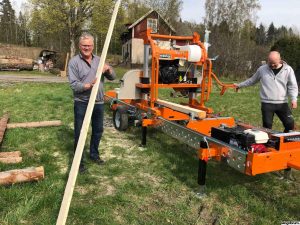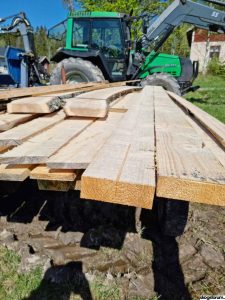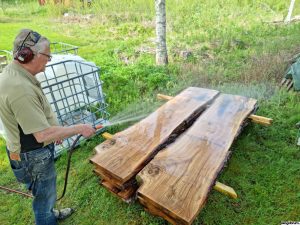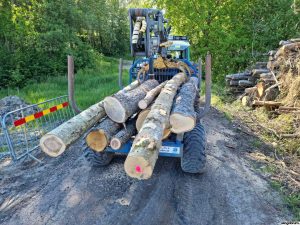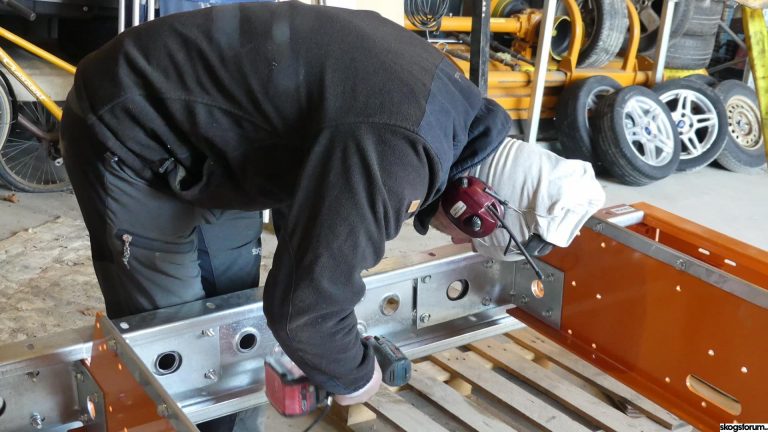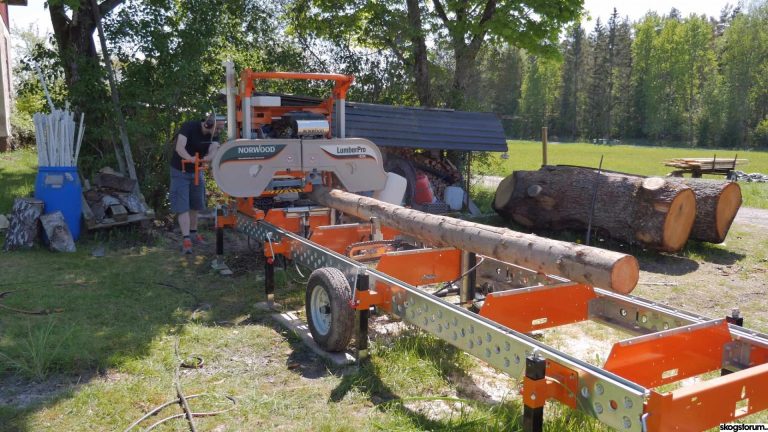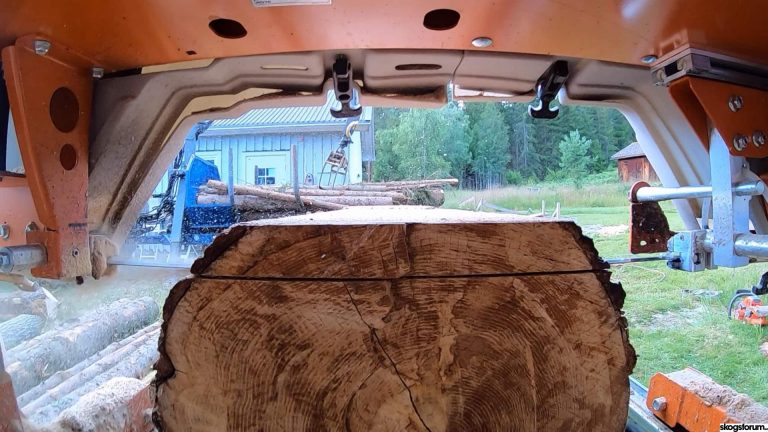During spring and summer 2021 the sister-site Skogsforum.se has tested the portable bandsaw Norwood LumberPro HD36. It´s a petrol-powered version of the saw and it was, for us, the first real test of a product that processes wood from the forest. It was an interesting journey.
This is a summary of an article signed by Fredrik Reuter at Skogsforum.se.
Norwood HD36 Bandsaw
Coming from the forestry business we have mainly tested products that are used in forestry. Chain- and clearing saws have often been subject to testing. We felt the time had come to take the next step, and that happened to be a portable sawmill. It was like a completely new World had opened for the testing team.
Please bear in mind that this is a test that should be read from the right angle – the testers are beginners and have no experience with mobile sawmills at all. Everything was completely new for them. The reflections and learnings that are shared in this article should be seen as some help for other beginners who consider acquiring a portable sawmill and start making their lumber.
Is a portable sawmill an investment?
A simple answer to that could be “Yes, absolutely!”. If you have the time, the interest, the need for lumber, and/or customers that want lumber. Especially a year like this when the lumber prices have reached the sky, and the bark-beetle keeps damaging the forest.
As mentioned above, our testing team had never tried to operate a sawmill before. But with some extra thinking and planning with the saw set, they soon figured it out quite easily. For construction wood for their building projects anyway.
Furthermore, depending on what you shall use the lumber for, if you don´t have to be too careful with the quality it makes it even easier. We had several logs that had lost the bark and apart from some blue stain we couldn´t see any difference compared to lumber from fresh logs. In other words, you can refine wood from your forest that you would normally get nothing for, or in the best case the price for fuel chips or firewood, if you sold it.
You must bear in mind though, that if you are a beginner (like us) you must count on that the yield (share of the log that becomes sawn timber/lumber) may not be so high in the beginning. You will probably miscalculate sometimes so that you don´t get the exact dimensions you wanted. This is a part of the process, you will get a hang of it, just keep trying.
Do slabs in between
Processing logs takes some thinking to get the saw set right. Each log is different which means it´s a new journey every time you lift another log up to the saw bed. To see the lumber pile grow is a good motivation that helps to keep you going, but eventually, you may lose your focus. When that happens it´s easy to call it a day, but we noticed that you could continue by doing some slabs – unedged lumber.
Here we are talking about unedged hardwood lumber. To collect different logs of oak, aspen, elm, rowan, etc. could be a good idea if you own a portable sawmill. Those could easily be sliced up in 2-inch unedged boards (or whatever you want) just to see what you get. Sawing hardwood like this is exciting and often a pure pleasure as you get unique raw material that you can either sell or process yourself.
The municipality had made several clear cuts for future industry estates and had piled up lots of material to be chipped. We kindly asked if we could take some logs in the piles, logs that had been rejected by the sawmills but could be a gold mine for the owner of a portable bandsaw. It was ok with the authorities, so we went to the piles and picked out some nice logs, nice to us anyway.
Norwood LumberPro HD36 – IKEA style
The test rig was supplied by the Swedish representative of Norwood, Skogma. We choose Norwood partly because we have a good relation to Skogma, but also because we find it exciting that Norwood has chosen the “IKEA model”, meaning that you assemble your sawmill yourself.
This keeps the price down and according to Skogma, you learn more about the mill if you do the assembly yourself. We can confirm that in addition to that you also learn things like that to read and follow the instructions could be a good idea and that it takes longer time than planned …
Norwood LumberPro HD36 is the largest bandsaw in the Norwood range. It can handle logs up to 92 cm (36”) diameter. This might not feel that big when you´re sitting by your computer or reading on your phone, but if you have handled logs of this size on a portable sawmill you know – it´s sturdy stuff.
The sawing is made with a bandsaw blade mounted between two cast band wheels. The wheels are powered by a Vanguard petrol engine of 23 hp. Between the engine and the wheels, there is a centrifugal clutch, meaning that the saw band stops when the engine is idling. The bandsaw blade is 4 meters (13 ft.) long and has almost 200 teeth.
The test saw was equipped with a trailer package. With a car, you can relatively easily move the mill between sites. At low speed should be mentioned, not more than 30 km/h (19 mi/h) is recommended. As the mill must be completely level when you are processing logs, you must count on 30 minutes extra time for each time you move the mill, just to set it up properly. Maybe not a big problem? It´s the cost for mobility.
There is no doubt that there are benefits to having the sawmill stationary on plain and solid ground. If the soil is soft where you operate, you must count on adjusting the setup daily or maybe even during the day.
Mounting – IKEA mounting on steroids
As mentioned before, a Norwood sawmill is delivered unmounted. In our case that meant four pallets with equipment. Some thousand inches of bolting later we were ready to go. But let´s go a bit deeper into that.
We had the benefit of mounting the mill indoors on a concrete floor. That is most likely not necessary but to be on a plain and hard floor makes it easier. If you are interested in a sawmill from Norwood and, like us, prefer to go ahead with the mounting without looking in the manual – pay attention!
Read the manual carefully. Take your time and follow the instructions. Do everything in the right order. All parts and packages are marked, so do follow this advice! To tear up all pallets and packages will end up with that you can´t find the parts or – in the worst case – use the wrong parts or put parts in the wrong place.
It took us 20 man-hours to do the mounting. Considering that we are who we are, always in a hurry, and not so keen on following instructions, this is the time you must calculate to get an acceptable result. A great help is a good outrunner as there are many bolts to be tightened.
As it is an American product the bolts and nuts are all in inch measurement so it´s a good idea to prepare with an inch socket wrench set. Millimeter sockets could however be used. We came a long way with a 14-mm and a 19-mm socket, but it is always better to use the right equipment.
Hydraulics – worth going for?
The sawmill that we mounted and tested was equipped with a hydraulic package. It meant that we could handle the logs hydraulically from the control panel. If it´s worth the extra cost or not is of course individual. With hydraulics, you don´t have to do so much heavy lifting, and the risk of injury is smaller. You also don´t have to run around so much during the saw setting for each log as you can stand by the control panel and do it. It´s up to everyone if it´s worth the extra cost.
The hydraulic package includes, apart from the parts on the saw bed, a hydraulic pump powered by a separate Honda engine, a hydraulic oil tank, and a hydraulic valve package.
Cuts like in butter but are careful
Our impression is that this bandsaw from Norwood works very well. On the occasions it didn´t work so well, it turned out that we didn´t follow the instructions or simply made something wrong.
There are ceramic supports for the bandsaw blade that, right set, make the blade saw straight and without problems. When it didn´t see straight, it was because we hadn´t checked the supports before starting to see. After adjusting the supports it goes fast and easy, almost like cutting in butter, with a nice saw kerf.
We learned the hard way that, apart from doing daily checks of the ceramic supports, you should always make sure that the log is properly attached to the saw bed, that the saw blade is sharp, and to take it easy when you move the saw unit back to the start position.
You can tie down the log both too hard and too loose on the saw bed. If it´s too loose there is a risk that the log moves during sawing. If it´s too hard you might get tensions in the log that affects the result negatively. As in many other operations, you must have the right feeling for what you are doing, not to stress, and keep an eye on what´s happening during the sawing operation.
Summarizing reflections
As this was our first test of a mobile sawmill, we can´t compare it to any of Norwood’s competitors. It is cheaper than most competitors because you must mount it yourself. As for quality, we can´t say that we found any problems. We have processed some 100 logs during the test with good results. The engines from Vanguard and Honda have, as expected, just “done their job” without problems.
Overall, it has been a good experience for the testing crew. A new World opened as they for the first time got to see what they can do. No matter if we talk about construction lumber of softwood or more exciting assortments of hardwood, this gives a deeper understanding of forestry. Also, you learn that you can do a lot with logs and pieces that traditional/professional sawmills wouldn´t call saw logs.
Here is a film from the test:
Film and photos: Fredrik Reuter and Torbjörn Johnsen






